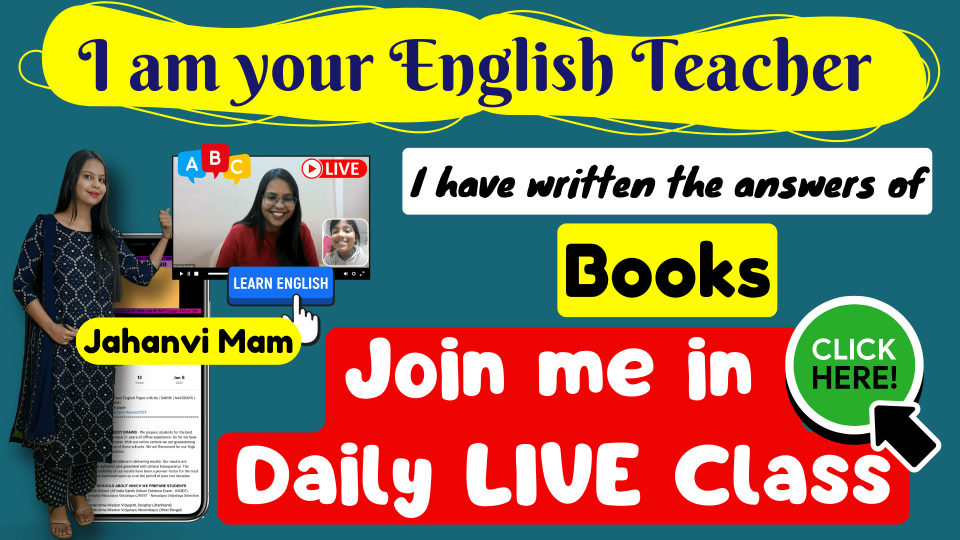Books - Class 4 English NCERT Solutions
Find complete solutions for the poem "Books," from Class 4 English NCERT. This poem expresses a child’s love for books, highlighting the joy and adventure they bring to young readers. The page offers accurate answers, key vocabulary, and extra questions to help students appreciate the importance of books while preparing for exams.
Summary of the Poem
English Summary:
The poem "Books" is a delightful description of a child's experience in a library. It begins with the welcoming invitation of the library door saying "Come in, come in!" As the child enters, they are amazed by the vast array of books available. The poem vividly describes the various types of books - tall and skinny ones high on the shelves, and little fat ones standing by themselves. The child picks up a book, sits down to look at it, and is captivated by the pictures that tell stories. The poem ends with the child's excitement at discovering how wonderful books can be.
Hindi Summary:
कविता "बुक्स" एक बच्चे के पुस्तकालय में अनुभव का सुखद वर्णन है। यह पुस्तकालय के दरवाजे के स्वागतपूर्ण निमंत्रण "अंदर आओ, अंदर आओ!" से शुरू होती है। जैसे ही बच्चा अंदर प्रवेश करता है, वह उपलब्ध पुस्तकों की विशाल श्रृंखला से चकित हो जाता है। कविता विभिन्न प्रकार की पुस्तकों का जीवंत वर्णन करती है - शेल्फ पर ऊंची और पतली किताबें, और छोटी मोटी किताबें जो अपने आप खड़ी हैं। बच्चा एक किताब उठाता है, उसे देखने के लिए बैठ जाता है, और उन चित्रों से मंत्रमुग्ध हो जाता है जो कहानियाँ बताते हैं। कविता बच्चे के उत्साह के साथ समाप्त होती है जब वह पता लगाता है कि किताबें कितनी अद्भुत हो सकती हैं।
Vocabulary List
| Sl | English Word | Hindi Meaning | English Meaning |
|---|---|---|---|
| 1 | Library | पुस्तकालय | A building or room containing collections of books for use or borrowing |
| 2 | Wide | चौड़ा | Of great or more than average width |
| 3 | Galore | बहुतायत | In abundance; in great numbers |
| 4 | Skinny | पतला | Very thin |
| 5 | Shelves | अलमारियाँ | Flat lengths of wood or other rigid material attached to a wall or forming part of a piece of furniture, used for supporting objects |
| 6 | Wonderful | अद्भुत | Inspiring delight, pleasure, or admiration; extremely good |
| 7 | Door | दरवाजा | A hinged, sliding, or revolving barrier at the entrance to a building, room, or vehicle |
| 8 | Opened | खोला | Move or adjust (a door or window) so as to leave a space allowing access and view |
| 9 | Saw | देखा | Past tense of see; perceive with the eyes |
| 10 | Tall | लंबा | Of great or more than average height |
| 11 | Fat | मोटा | Having a large amount of excess flesh |
| 12 | Stood | खड़ा था | Past tense of stand; be in an upright position |
| 13 | Pictures | चित्र | A painting or drawing |
| 14 | Told | बताया | Past tense of tell; communicate information to someone in spoken or written words |
| 15 | Stories | कहानियाँ | An account of imaginary or real people and events told for entertainment |
Answers to the Exercises
Reading is fun
- What did the library door say?
The library door said, "Come in, come in!" - What did the books in the library look like?
The books in the library looked different from each other. There were tall skinny books up high on the shelves and little fat books that stood by themselves. - Why did the child in the poem like looking at the pictures?
The child liked looking at the pictures because they told stories. The poem says, "The pictures told stories! What a wonderful book!"
Let's listen
Listen to the words:
Come in, come in
Go out, go out
What word signs have you seen or heard –
- at home: (e.g., "Welcome", "Home Sweet Home")
- at the vegetable shop: (e.g., "Fresh Vegetables", "Best Prices")
- at the library: (e.g., "Silence Please", "Return Books Here")
- at the doctor's place: (e.g., "Wait Your Turn", "Consultation Hours")
- at the bus stop: (e.g., "Bus Stop", "No Smoking")
- at the toy shop: (e.g., "Sale!", "New Arrivals")
Let's talk
- Do you like reading story books?
(This is a personal question. Students should answer based on their own preferences.) - What kinds of stories do you like?
(This is a personal question. Students might mention genres like adventure, fantasy, fairy tales, etc.) - The word 'galore' means 'in great numbers'. Do you also have a class library or a school library which keeps many books? Can you borrow books?
(This question depends on the student's school. They should answer based on their school's facilities.) - Tell the class about your favourite story book. Talk about the character you liked most in the book.
(This is a personal question. Students should share about their favorite book and character.)
Let's play
The "Book Chain" game is described in the poem. Students form groups and create a chain by saying the names of different story books.
Let's write
Make word families. The first word in each has been written for you.
ook family:
- look
- cook
- shook
- brook
- book
ell family:
- well
- bell
- spell
- tell
- shell
ee family:
- see
- three
- bee
- tree
ail family:
- tail
- trail
- rail
Now fill in the blanks after reading these sentences:
- An airport is a place where aeroplanes take off and land.
- A kitchen is a place where food is cooked.
- A hospital is a place where sick people are taken care of.
- A shop is a place where you can buy things.
- A school is a place where children study.
Additional Short Answer Questions
- What does the library door's invitation suggest about libraries?
The library door's invitation suggests that libraries are welcoming places that encourage people to come in and explore. - How does the poem describe the variety of books in the library?
The poem describes books of different sizes and shapes, mentioning "tall skinny books" and "little fat books". - What action does the child take after seeing all the books?
The child opens one book and sits down to look at it. - What does the child discover about the book they opened?
The child discovers that the pictures in the book tell stories. - How does the poem convey the child's excitement about books?
The poem conveys the child's excitement through the exclamation "What a wonderful book!" - What does the word "galore" mean in the context of the poem?
In the context of the poem, "galore" means in great numbers or abundance. - How does the poem describe the placement of books on the shelves?
The poem mentions that tall skinny books are "up high on the shelves". - What does the phrase "stood by themselves" suggest about the little fat books?
The phrase suggests that the little fat books were thick enough to stand upright without support. - How does the structure of the poem help in creating a visual image of the library?
The poem uses short, descriptive lines to create a clear visual image of the library and its books. - What senses does the poem appeal to?
The poem primarily appeals to the sense of sight, describing the visual aspects of the books and library. - How might this poem encourage children to visit libraries?
The poem presents libraries as exciting places full of wonderful books, which might make children curious to visit and explore libraries themselves. - What does the poem suggest about the importance of pictures in books for children?
The poem suggests that pictures in books are important as they can tell stories and make books more engaging for children. - How does the poem portray the act of reading?
The poem portrays reading as an enjoyable and exciting activity, full of discovery. - What message does this poem convey about libraries?
The poem conveys that libraries are welcoming places filled with a wide variety of interesting books waiting to be explored. - How might the experience described in the poem differ from reading digital books?
The poem emphasizes the physical aspects of books and libraries, such as different sizes and shapes of books, which might be different from the experience of reading digital books.
The Speedy Brains APP Download
Over 15000 students from all over India rely on our The Speedy Brains App for their School Exams. 850 Satisfied students have given 5 star review to our Android app on Google Play Store.
- Best Online LIVE Class APP
- Live Class Recordings
- Unlimited Practice Tests
- Previous Year Questions
- 800+ 5star Ratings

